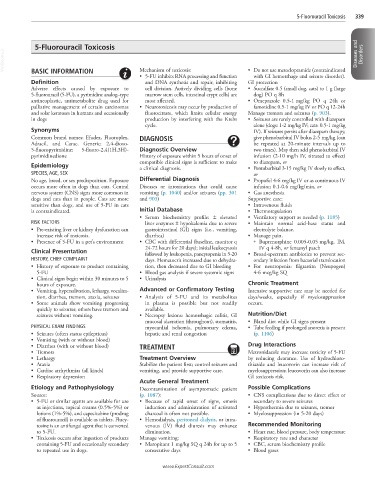Page 727 - Cote clinical veterinary advisor dogs and cats 4th
P. 727
5-Fluorouracil Toxicosis 339
5-Fluorouracil Toxicosis
VetBooks.ir Diseases and Disorders
Mechanism of toxicosis:
BASIC INFORMATION
with GI hemorrhage and seizure disorder).
• 5-FU inhibits RNA processing and function • Do not use metoclopramide (contraindicated
Definition and DNA synthesis and repair, inhibiting GI protection
Adverse effects caused by exposure to cell division. Actively dividing cells (bone • Sucralfate 0.5 (small dog, cats) to 1 g (large
5-fluorouracil (5-FU), a pyrimidine analog–type marrow stem cells, intestinal crypt cells) are dog) PO q 8h
antineoplastic, antimetabolite drug used for most affected. • Omeprazole 0.5-1 mg/kg PO q 24h or
palliative management of certain carcinomas • Neurotoxicosis may occur by production of famotidine 0.5-1 mg/kg IV or PO q 12-24h
and solar keratoses in humans and occasionally fluorocitrate, which limits cellular energy Manage tremors and seizures (p. 903).
in dogs production by interfering with the Krebs • Seizures are rarely controlled with diazepam
cycle. alone (dogs: 1-2 mg/kg IV; cats: 0.5-1 mg/kg
Synonyms IV). If seizures persist after diazepam therapy,
Common brand names: Efudex, Fluoroplex, DIAGNOSIS give phenobarbital IV bolus 2-5 mg/kg (can
Adracil, and Carac. Generic: 2,4-dioxo- be repeated at 20-minute intervals up to
5-fluoropyrimidine; 5-fluoro-2,4(1H,3H)- Diagnostic Overview two times). May then add phenobarbital IV
pyrimidinedione History of exposure within 5 hours of onset of infusion (2-10 mg/h IV, titrated to effect)
compatible clinical signs is sufficient to make to diazepam, or
Epidemiology a clinical diagnosis. • Pentobarbital 3-15 mg/kg IV slowly to effect,
SPECIES, AGE, SEX or
No age, breed, or sex predisposition. Exposure Differential Diagnosis • Propofol 4-6 mg/kg IV or as continuous IV
occurs more often in dogs than cats. Central Diseases or intoxications that could cause infusion 0.1-0.6 mg/kg/min, or
nervous system (CNS) signs more common in vomiting (p. 1040) and/or seizures (pp. 301 • Gas anesthesia
dogs and cats than in people. Cats are more and 903) Supportive care:
sensitive than dogs, and use of 5-FU in cats • Intravenous fluids
is contraindicated. Initial Database • Thermoregulation
• Serum biochemistry profile: ± elevated • Ventilatory support as needed (p. 1185)
RISK FACTORS liver enzymes ± hypokalemia due to severe • Maintain normal acid-base status and
• Pre-existing liver or kidney dysfunction can gastrointestinal (GI) signs (i.e., vomiting, electrolyte balance.
increase risk of toxicosis. diarrhea) • Manage pain.
• Presence of 5-FU in a pet’s environment • CBC with differential (baseline, monitor q ○ Buprenorphine 0.005-0.05 mg/kg, IM,
24-72 hours for 20 days); initial leukocytosis IV q 4-8h, or fentanyl patch
Clinical Presentation followed by leukopenia, pancytopenia in 5-20 • Broad-spectrum antibiotics to prevent sec-
HISTORY, CHIEF COMPLAINT days. Hematocrit increased due to dehydra- ondary infection from bacterial translocation
• History of exposure to product containing tion, then decreased due to GI bleeding • For neutropenia: filgrastim (Neupogen)
5-FU • Blood gas analysis if severe systemic signs 4-6 mcg/kg SQ
• Clinical signs begin within 30 minutes to 5 • Urinalysis
hours of exposure. Chronic Treatment
• Vomiting, hypersalivation, lethargy, vocaliza- Advanced or Confirmatory Testing Intensive supportive care may be needed for
tion, diarrhea, tremors, ataxia, seizures • Analysis of 5-FU and its metabolites days/weeks, especially if myelosuppression
• Some animals show vomiting progressing in plasma is possible but not readily occurs.
quickly to seizures; others have tremors and available.
seizures without vomiting. • Necropsy lesions: hemorrhagic colitis, GI Nutrition/Diet
mucosal ulceration (throughout), stomatitis, • Bland diet while GI signs present
PHYSICAL EXAM FINDINGS myocardial ischemia, pulmonary edema, • Tube feeding if prolonged anorexia is present
• Seizures (often status epilepticus) hepatic and renal congestion (p. 1106)
• Vomiting (with or without blood)
• Diarrhea (with or without blood) TREATMENT Drug Interactions
• Tremors Metronidazole may increase toxicity of 5-FU
• Lethargy Treatment Overview by reducing clearance. Use of hydrochloro-
• Ataxia Stabilize the patient first; control seizures and thiazide and leucovorin can increase risk of
• Cardiac arrhythmias (all kinds) vomiting, and provide supportive care. myelosuppression; leucovorin can also increase
• Respiratory depression GI toxicosis risk.
Acute General Treatment
Etiology and Pathophysiology Decontamination of asymptomatic patient Possible Complications
Source: (p. 1087): • CNS complications due to direct effect or
• 5-FU or similar agents are available for use • Because of rapid onset of signs, emesis secondary to severe seizures
as injections, topical creams (0.5%-5%) or induction and administration of activated • Hyperthermia due to seizures, tremor
lotions (1%-5%), and capecitabine (prodrug charcoal is often not possible. • Myelosuppression (in 5-20 days)
of fluorouracil) is available as tablets. Flucy- • Hemodialysis, peritoneal dialysis, or intra-
tosine is an antifungal agent that is converted venous (IV) fluid diuresis may enhance Recommended Monitoring
to 5-FU. elimination. • Heart rate, blood pressure, body temperature
• Toxicosis occurs after ingestion of products Manage vomiting: • Respiratory rate and character
containing 5-FU and occasionally secondary • Maropitant 1 mg/kg SQ q 24h for up to 5 • CBC, serum biochemistry profile
to repeated use in dogs. consecutive days • Blood gases
www.ExpertConsult.com

